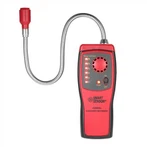What does temperature compensation of pH meter mean? How to apply temperature compensation?
A pH meter, also known as an acidity meter, is an instrument used to measure the pH of a liquid. When we use a pH meter, we will see a "temperature compensation" function on the instrument. What does this mean? What is the role of temperature compensation? When does temperature compensation need to be applied? How to use this function? Many friends who are new to the pH meter may be full of doubts about this.
The role of pH meter temperature compensation
The temperature compensation function is mainly used to correct the deviation caused by the difference between the temperature of the standard buffer such as the standard buffer (generally 25 degrees Celsius) and the actual sample solution temperature during calibration.
To understand why this is done, first understand how a pH meter measures pH. The method of measuring pH with a pH meter is based on the principle of the Nernst equation. The electromotive force of the electrode has a linear relationship with the pH value. Usually, two buffer solutions with different pH values are used for calibration in the pH meter to determine the slope of the curve. This slope is proportional to temperature.
For a strong electrolyte solution, when the solution temperature changes, the concentration of hydrogen ions in the solution remains approximately constant, that is, when the pH value of the solution remains constant, according to the Nernst equation, the ΔE of the solution will vary linearly with the temperature T. As the temperature rises, the electromotive force of the solution will increase, and the acidity meter converts the pH value based on the detected electromotive force of the solution, so temperature compensation must be performed to offset the influence of temperature on the measurement results. This is the nature of pH meter temperature compensation.
When to Use Temperature Compensation
Temperature compensation can be used when the temperature of the sample solution is different from that of the standard solution when making pH measurement with general accuracy.
However, when doing high-precision measurement, try not to use automatic temperature compensation, but need to look up the table after measurement to obtain the pH value of the solution at 25°C, or wait until the solution reaches 25°C before measuring.
Now many pH meters have automatic temperature compensation function. When automatic temperature compensation is used, the instrument converts the conversion coefficient obtained by the electrode at the calibration temperature to the conversion coefficient at the actual temperature according to the Nernst formula, so as to obtain the pH at the actual temperature. value.
Instruments without automatic temperature compensation function need to perform temperature compensation manually, and this operation is possible when the accuracy requirement is not high.
In fact, neither manual temperature compensation nor automatic temperature compensation is sufficient. According to the operational definition of pH meter measurement, in order to obtain precise measurement results, the sample solution and the standard solution should be measured at the same and constant temperature, which is the principle of isothermal measurement.
In order to reduce the error of temperature to pH measurement, we should try our best to choose the standard buffer solution close to the pH value of the measured solution, and try to make the temperature of the calibration solution consistent or close to the temperature of the measured solution.






